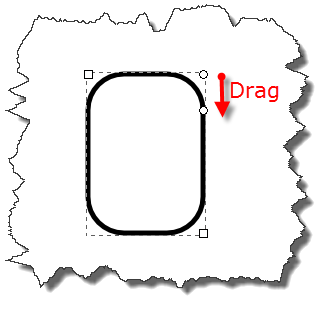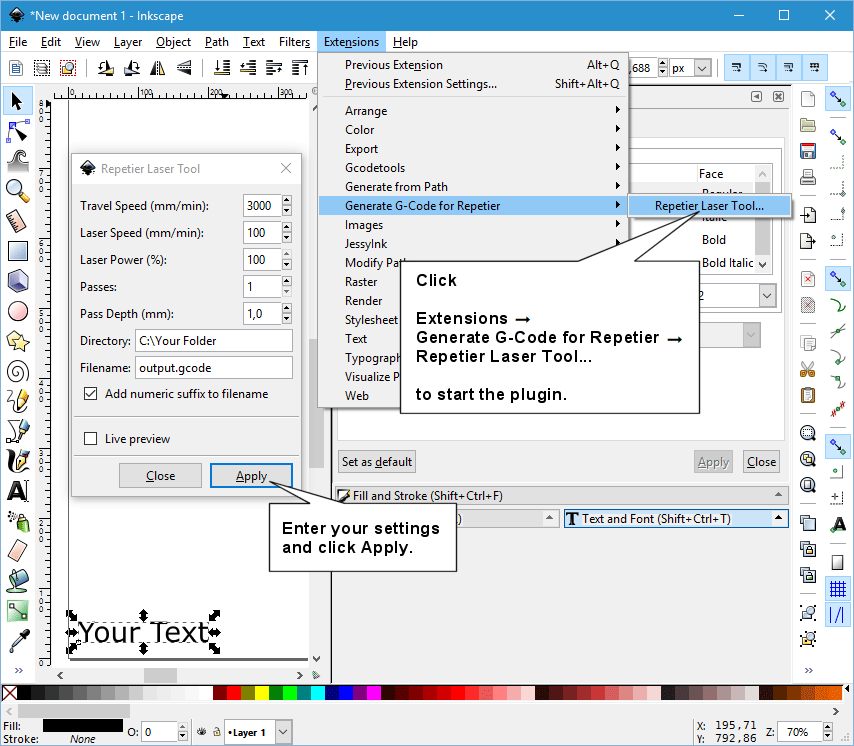
- #INKSCAPE GCODE TOOL SHAPE HOW TO#
- #INKSCAPE GCODE TOOL SHAPE INSTALL#
- #INKSCAPE GCODE TOOL SHAPE CODE#
This tutorial does not cover all functions of the extension, there are much more of them such:Īll manuals, tutorials and source codes are available here: This image is out of date - see the links for a current version. You will get a new group that contains a kind of preview of generated Gcode (straight lines (G01) are painted in red, arcs (G02 and G03) are painted in blue and green).Īnd of course you will get your Gcode file in the selected directory.
Select "Curve to Gcode" or "Path to Gcode". Filename and dir (If selected directory contains 'header' or 'footer' file they will be used as header and footer for your Gcode). Then TEXT > TEXT and FONTS (or shift + control + T) Select the text box containing the parameter to edit Add a tool with "Tool Library" (v1.7 tool information is stored in a text box on the active layer). Once all objects in the selection are paths do Extensions->Gcode tools.  Repeat Object->Ungroup (Shift+Ctrl+G) until there's no more groups in the selection. Select all objects and look at the status bar at bottom of window what is selected if it says something like "2 objects of type Path" it is fine. You can find some ready svg files (like I did).
Repeat Object->Ungroup (Shift+Ctrl+G) until there's no more groups in the selection. Select all objects and look at the status bar at bottom of window what is selected if it says something like "2 objects of type Path" it is fine. You can find some ready svg files (like I did). Here's simple tutorial how to convert path to Gcode: If it's necessary instead of biarc simple straight interpolation is used.
Paths are converted using biarc interpolation, which means that each segment of path interpolates by two arcs (two G02 or G03 code lines).
This extension converts paths that are selected to Gcode. With root priviledges, copy the following files to your /usr/share/inkscape/extensions directory (for Windows it's \Program Files\Inkscape\share\extensions\). For current instructions see the link above. Most of the directions below are based on v1.2. Note: Version 1.7 is the latest stable version. Get the latest version of Gcode Tools () from for English users, and for Russian users. From Ubuntu package manager, install Inkscape or just run in console 'sudo apt-get install inkscape'. Gcodetools Setup of Inkscape (and Gcodetools scripts) on Ubuntu Inkscape can operate in "pixels", "millimeters", or "inches". Inkscape can manipulate bitmaps, fonts and objects, all of which can be converted to paths.  Inkscape is a 2D vector drawing program that can be used for drafting. For other convertors, Inkscape can export to various formats, including. In addition to the two extensions within Inkscape, it is also possible to use external gcode generators such as p圜AM. Gcodetools has been accepted into the main code base of Inkscape and will be available without any extra effort starting with the 0.48 release. This page describes both ways to convert Inkscape paths to gcode files. The newer extension is called "Gcodetools"and the older extension is called "gcode." both extensions work.
Inkscape is a 2D vector drawing program that can be used for drafting. For other convertors, Inkscape can export to various formats, including. In addition to the two extensions within Inkscape, it is also possible to use external gcode generators such as p圜AM. Gcodetools has been accepted into the main code base of Inkscape and will be available without any extra effort starting with the 0.48 release. This page describes both ways to convert Inkscape paths to gcode files. The newer extension is called "Gcodetools"and the older extension is called "gcode." both extensions work. 
There are two separate extensions to Inkscape to create gcode.

It is easy to add extensions to Inkscape for special functions. You can think of it as either a drawing package that uses the Scalable Vector Graphics (SVG) format as its native format, or as a graphical editor for SVG files. Among other capabilities, it is a fully-functional 2D CAD program. Inkscape is a powerful Open Source 2D drawing package.








 0 kommentar(er)
0 kommentar(er)
